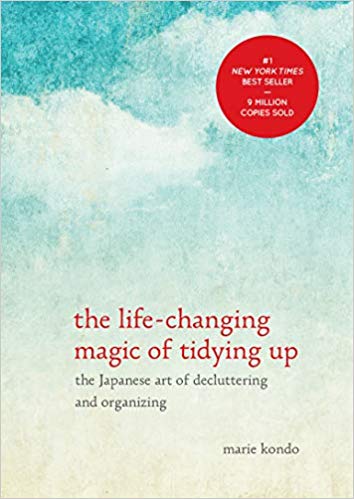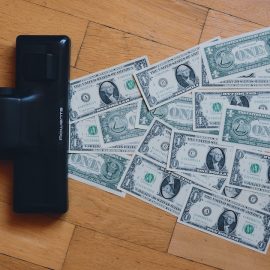

This article is an excerpt from the Shortform summary of "The Life-Changing Magic of Tidying Up" by Marie Kondo. Shortform has the world's best summaries of books you should be reading.
Like this article? Sign up for a free trial here .
Marie Kondo’s Komono Method, at a High Level
Many of us have difficulty keeping our homes tidy because we were never taught how. But tidying is a simple act, and there are actually only a few reasons why we have difficulty tidying. People who can’t tidy fall into three categories: they can’t get rid of things, they can’t organize things, or a combination of both–most of us fall into the last category.
The basic Marie Kondo Komono process is to discard first, then organize what’s left.
Most people tidy by going through a small portion of objects first, usually by convenience, and then trying to put that small portion away before they start on everything else.
The KonMari process helps you avoid these stopping points. Don’t do it little by little, do your whole house in one go (as much as you can depending on your schedule–it’s fine if it takes up to 6 months).And go by category, not by room.
For each category, gather all the items together in a giant pile, discard first, then organize what’s left.
Marie Kondo on Komono Specifics
Komono means “miscellany.” This category of Komono encompasses a lot of stuff, but it’s also the category that contributes the most to clutter. Don’t surround yourself with things that you don’t use and don’t bring you joy.
Here are the categories that fall under komono, per Marie Kondo:
- CDs and DVDs
- Skin care products
- Makeup
- Accessories
- Valuables like credit cards, passports, medical cards
- If you have a lot of items related to a particular hobby, like skiing, include them here
- Electrical equipment and appliances like cameras, cords, anything electric
- Household equipment like stationery and sewing kits
- Household supplies like detergent, medicine, tissues
- Kitchen goods and food supplies like spatulas, dishes, pots
- Any other small categories like tchotchkes, figurines, spare change
Look at the order of that list: it’s an intentional order that goes from more personal items to more communal items.
- If you live alone, you don’t need to worry about this distinction, but if you live with people, then the order becomes useful. When you get to this category, use this order for maximum efficiency–it’s easier to calibrate what sparks joy for you alone before you try to work with another person to discard items you share.
Many of the items in this category are things we keep “just because.” This results in many odds and ends that take up space and clutter our homes.
Konmari Komono Step 1: Discarding
Here are some common areas of difficulty in this category:
- Gifts
- The purpose of a present is to be received, and to convey the giver’s feelings of affection. A gift accomplishes these 2 things at the very moment it’s given, but then a lot of us end up keeping gifts someone gave us that we don’t use or even like. Don’t do this. Thank it for the joy it gave you when you first received it, and discard it.
- Cosmetic samples
- These products are smaller sized and consequently have shorter shelf lives. You don’t want to use expired cosmetics when you’re traveling! Trash them. Get reusable travel sized bottles instead.
- Electronic packaging
- Many people save boxes in this category thinking it will make the electronic more valuable if they want to sell it one day, and for some items, it might. But if you think of your home as storage space that costs money to maintain, do you think having the box for that electronic will recoup all the money you paid in the years you let it take up space?
- Exception: we mentioned that Apple boxes and similar quality boxes make great organizers, so you might save some of these to use as organizing tools.
- Cords
- If you don’t know what a cord is for, you probably don’t need it. Keep the cords you can immediately identify and discard the rest. A tangle of cords just makes it harder to find the one you need.
- Broken appliances.
- If it’s broken, discard it.
- If you’re worried about disposing of appliances responsibly, look into your local waste management company to see if they do special pick-ups or have a list of what items to recycle.
- If you don’t want the money you spent on it to go to waste, see if you have an active warranty on it, or look into getting it repaired. Otherwise, thank it for its service as you discard it.
- Spare bedding
- If you host friends and family a lot, you might need more spare bedding than other people. But if you have visitors once or twice a year at most, you really only need one set of spare bedding. Bedding that’s stored away for too long gets musty, and that’s not how you want to treat your guests.
- Spare buttons
- Discard these. If you really want to keep the spare buttons, sew them into the lining of the garment right when you get it. If you lose a button, you can always go to the local craft store to find a similar one. Most people, if they lose a button, either keep wearing the garment without replacing it or leave the garment in their closet never to be worn again–even if they have the spare buttons.
- Health craze products
- These usually cost a lot of money, which makes us less likely to want to discard them. But let them go if you don’t use them and they don’t spark joy. Thank them for their service–if you actually used them, or if they just gave you a thrill when you bought them…
———End of Preview———

Like what you just read? Read the rest of the world's best summary of Marie Kondo's "The Life-Changing Magic of Tidying Up" at Shortform . Learn the book's critical concepts in 20 minutes or less .
Here's what you'll find in our full Marie Kondo summary :
- The psychological benefits of tidying
- How to Tidy the Konmari method
- How to deal with Clothing, Books, Papers, and Sentimental Items
- ...and much more






